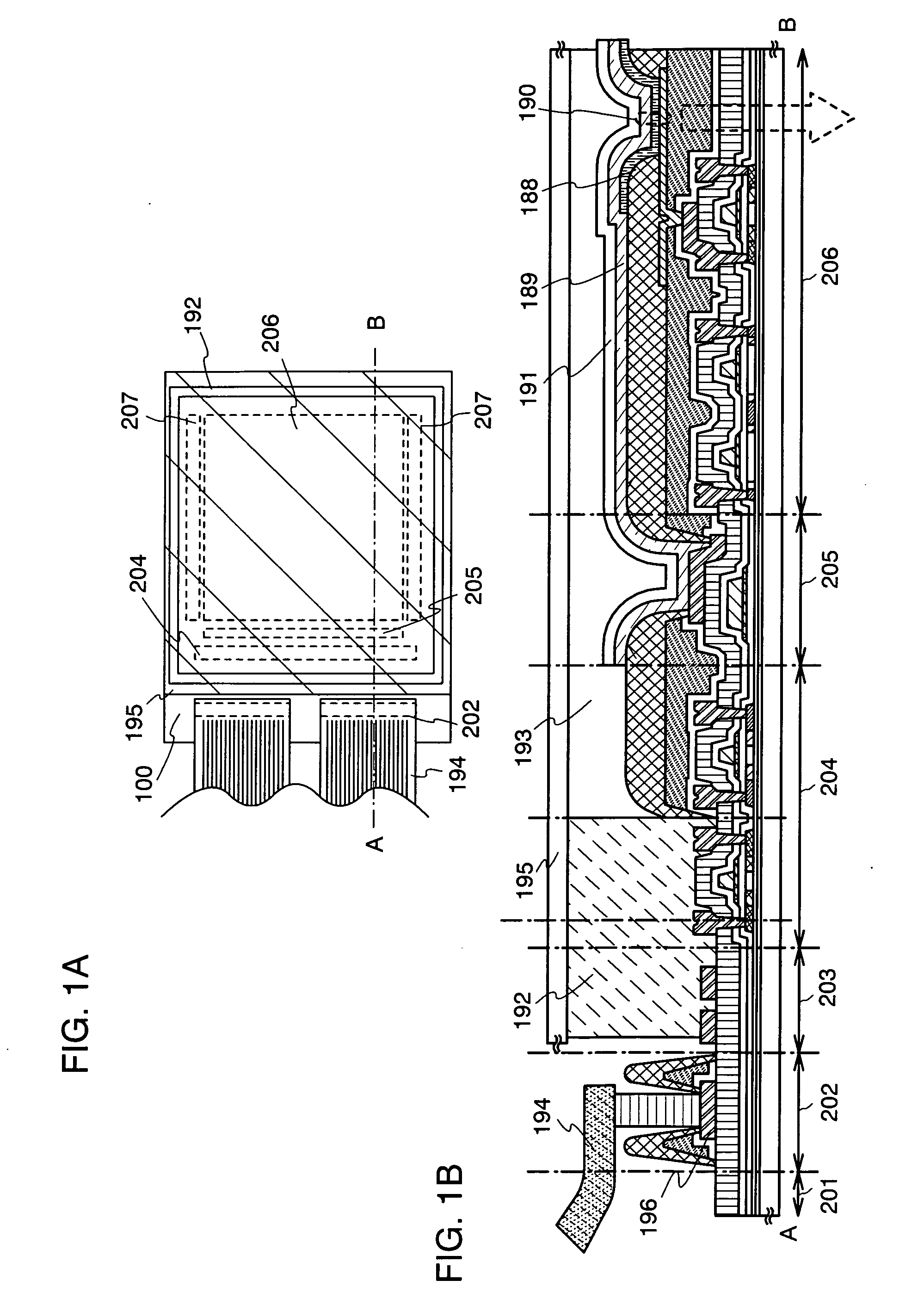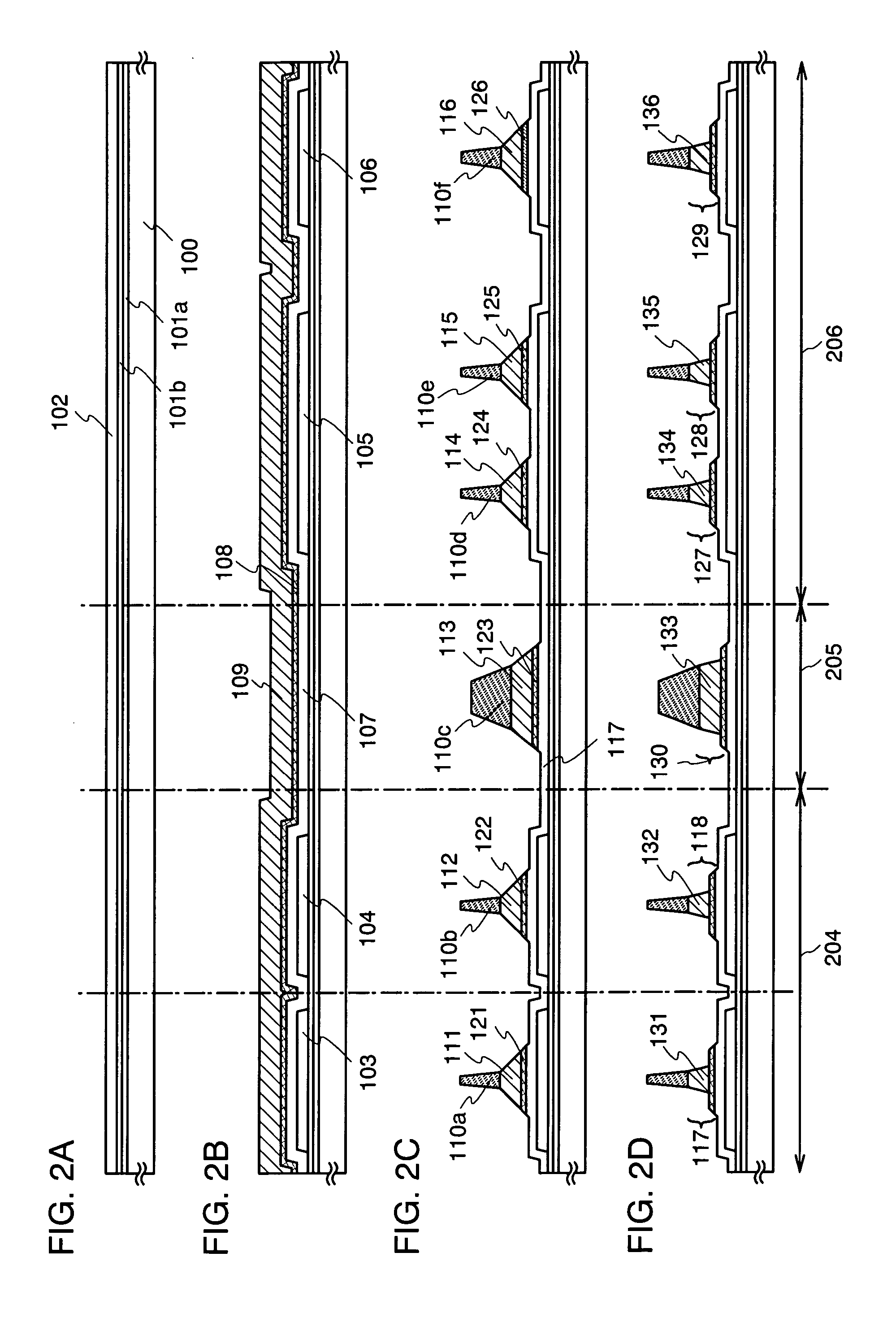Display device and method for manufacturing the same
- Summary
- Abstract
- Description
- Claims
- Application Information
AI Technical Summary
Benefits of technology
Problems solved by technology
Method used
Image
Examples
embodiment mode 1
[0041] A method for forming a thin film transistor in Embodiment Mode 1 is described in detail with reference to FIGS. 1A to 6B.
[0042] In addition, FIG. 16A shows a top view of a structure of a display panel according to the present invention. A pixel portion 2701 in which pixels 2702 are arranged in matrix, a scanning line input terminal 2703, and a signal line input terminal 2704 are formed over a substrate 2700 having an insulating surface. The number of pixels may be provided according to various standards. The number of pixels of XGA may be 1024×768×3 (RGB), that of UXGA may be 1600×1200×3 (RGB), and that of a full-speck high vision may be 1920×1080×3 (RGB).
[0043] The pixels 2702 are arranged in matrix by intersecting a scanning line extended from the scanning line input terminal 2703 with a signal line extended from the signal line input terminal 2704. Each pixel 2702 is provided with a switching element and a pixel electrode connected thereto. A typical example of the switc...
embodiment mode 2
[0132] Embodiment Mode according to the present invention is described with reference to FIGS. 7A to 9. Embodiment Mode 2 describes an example in which a second interlayer insulating film is not formed in the display device manufactured in Embodiment Mode 1. Therefore, the description of the same portions and the portions having the same function is omitted.
[0133] As shown in Embodiment Mode 1, thin film transistors 173 to 176, a conductive layer 177, and insulating films 167 and 168 are formed over a substrate 100. A source or drain electrode layer to be connected to a source or drain region of a semiconductor layer is formed in each thin film transistor. A first electrode layer 395 is formed to be in contact with a source or drain electrode layer 172b in the thin film transistor 176 provided in a pixel region 206 (FIG. 7A).
[0134] The first electrode layer 395 serves as a pixel electrode, and may be formed from the same material in the same process as the first electrode layer 18...
embodiment mode 3
[0138] Embodiment Mode according to the present invention is described with reference to FIGS. 10A to 10C. Embodiment Mode 3 describes an example in which a gate electrode layer of a thin film transistor has a different structure in the display device manufactured in Embodiment Mode 1. Therefore, the description of the same portions and the portions having the same function is omitted.
[0139]FIGS. 10A to 10C show a display device that is being formed in a manufacturing process and corresponds to the display device shown in FIG. 4B described in Embodiment Mode 1.
[0140] In FIG. 10A, thin film transistors 273, 274 are formed in a peripheral driver circuit region 214, a conductive layer 277 is formed in a connection region 215, and thin film transistors 275, 276 are formed in a pixel region 216. A gate electrode layer of a thin film transistor in FIG. 10A has a stacked structure of two conductive films, in which an upper gate electrode layer is patterned to have a width narrower than a...
PUM
 Login to View More
Login to View More Abstract
Description
Claims
Application Information
 Login to View More
Login to View More - R&D
- Intellectual Property
- Life Sciences
- Materials
- Tech Scout
- Unparalleled Data Quality
- Higher Quality Content
- 60% Fewer Hallucinations
Browse by: Latest US Patents, China's latest patents, Technical Efficacy Thesaurus, Application Domain, Technology Topic, Popular Technical Reports.
© 2025 PatSnap. All rights reserved.Legal|Privacy policy|Modern Slavery Act Transparency Statement|Sitemap|About US| Contact US: help@patsnap.com



